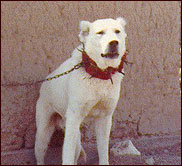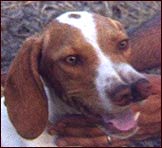A white-colored lifestock guard dog from Western Turkey, which bears some similarities with (and maybe related to) some other white flock guarders, such as the Komondor, Tatra Mountain Sheepdog, Kuvasz and the Pyrenean Mountain Dog. As compared to the Kangal dog, the Akbash dog has a more "tucked-up" appearance, showing signs of greyhound or gazehound influence.
Both breeds are often seen in their native land wearing an iron, spiked collar, often with a piece of cloth underneath it to protect their necks and sporting "cropped" ears as are seen here on this mature male Akbash Dog in the Sivrihisar region.
Anatolian Shepherd Dog
The Anatolian Shepherd Dog is a muscular, broad-headed flock guardian dog breed native to Anatolia (Turkey). The Anatolian shepherd comes in various colors which keep close to the original wolf grey. The main or base color of the breed is wolf grey and includes white, yellow and black. The perfect blend of these colors includes white, black and yellow in the right proportion is known as agouti. However, all tan or all white specimens also appear in some regions of Anatolia.
.
.
.
.









